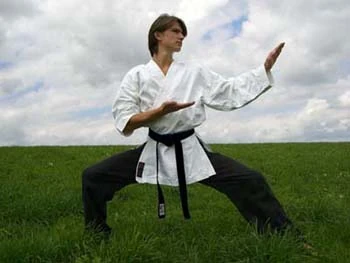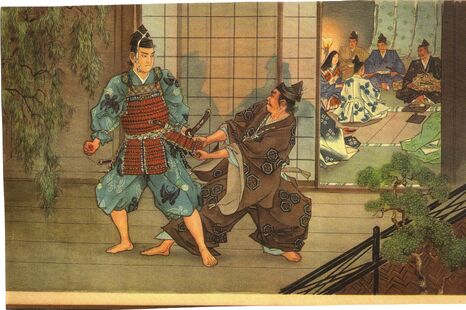| Karate | |
|---|---|

| |
| Also called | Karate-dō |
| Country of origin | Okinawa |
| Descendant arts | Taekwondo |
| Focus | Striking |
Karate is a martial art developed in the Ryukyu Islands (Okinawa, Japan) from indigenous fighting methods te (手, literally: "hand") and Chinese kenpō. Karate is characterized as a striking art using punching, kicking, knee and elbow strikes and open-handed striking techniques such as knife-hands (the famous "karate chop") and palm strikes. Grappling, locks, restraints, throws, and vital point strikes are taught in some styles. A karate practitioner is called as a karateka.The WKF claims that there are 100 million practitioners worldwide.
History[]
Karate developed in the Ryukyu Kingdom prior to its 19th century annexation by Japan. It was brought to the Japanese mainland in the early 20th century during a time of cultural exchanges between the Japanese and the Ryukyuans. In 1922 the Japanese Ministry of

Education invited Gichin Funakoshi to Tokyo to give a karate demonstration. Keio University became the first Japanese university to open a dojo; by 1932, all Japanese universities had dojo. After the second world war, Okinawa became an important United States military site and karate became popular among servicemen stationed there.
The martial arts movies of the 1960s and 1970s served to greatly increase its popularity, and the word karate began to be used in a generic way to refer to all striking-based Oriental martial arts. Karate schools began appearing across the world, catering to those with casual interest as well as those seeking a deeper study of the art.
Styles[]
- Gojo-Ryu
- Isshin-Ryu
- Shotokan
- Kyokushin
- Chito ryu
- Shidokan
In Japan[]
Gichin Funakoshi (1868-1957), founder of Shotokan karate, is generally credited with having introduced and popularized karate on the main islands of Japan. In addition many Okinawans were actively teaching, and are thus also responsible for the development of karate on the main islands of Japan.
Techniques and Stances[]
| Japanese | English |
|---|---|
| Dachi | Stance |
| Heisoku Dachi | Closed foot stance (feet together) |
| Musubi Dachi | Heels together - feet at an angle |
| Heiko Dachi | Parallel stance (feet shoulder width apart) |
| Hachiji Dachi | Natural stance (feet shoulder width apart - toes slightly pointed out) |
| Shiko Dachi | Straddle leg stance |
| Kiba Dachi | Horse riding stance |
| Sanchin Dachi | Hourglass stance |
| Zen Kutsu Dachi | Front Stance |
| Han Zen Kutsu Dachi | Half front stance |
| Fudo Dachi | Free stance |
| Kokutsu Dachi | Back stance |
| Neko Ashi Dachi | Cat stance |
| Renoji Dachi | "L" stance |
| Seisan Dachi | Side facing straddle stance |
| Koshi Dachi | Squat stance |
| Japanese | English |
|---|---|
| Suri Ashi | Sliding step |
| Tsugi Ashi | Shuffling step |
| Ayumi Ashi | Natural stepping |
| Yori Ashi | Dragging step |
| Keri Ashi | Kicking foot |
| Tenshin | Moving |
| Chakuchi | Landing |
| Issoku-cho | One foot length |
| Japanese | English |
|---|---|
| Zuki | Punch |
| Uchi | Strike |
| Age Zuki | rising punch |
| Kagi Zuki | hook punch |
| Yama Zuki | Mountain punch |
| Awase Zuki | Two handed punch |
| Heiko Zuki | Parallel punch |
| Hasami Zuki | Scissors punch |
| Nagashi Zuki | Flowing punch |
| Ko Uchi | Bent wrist strike |
| Washi-De | Eagle hand |
| Kaisho | Open hand |
| Choku Zuki | Straight punch |
| Ura Zuki | Upper punch |
| Uraken Uchi | Back fist strike |
| Furi Zuki | Circular punch |
| Mawashi Zuki | Round hook punch |
| Tate Zuki | Vertical punch |
| Kizami Zuki | Jab punch |
| Oi Zuki | Lunge punch |
| Gyaku zuki | Reverse punch |
| Nihon Zuki | Double punch |
| Sanbon Zuki | Triple punch |
| Jun Zuki | Leading punch |
| Morote Zuki | Two fisted punch |
| Furi Sute | Whip swing |
| Hojo Oshi | Augmented push |
| Tsukami Hiki | Grab-pull |
| Ashi Dori | Leg take down |
| Toki Waza | Freeing technique |
| Hazushi Waza | Throwing-off technique |
| Nage Waza | Throwing technique |
| haito Uchi | ridge hand |
| hiji uchi (empi) | elbow strike |
| kaiko-ken | flat fist |
| koken | bent wrist |
| nakadaka-ken | middle finger knuckle fist |
| nukite Uchi | finger thrust |
| seiken | fist |
| shotei Uchi | palm of hand |
| shuto Uchi | knife hand |
| tettsui | hammer hand |
| yubi hasami | finger pincOther |
More Information[]
There are plenty pages, which deliver further information about martial arts in general or to certain sports, like judo, karate...